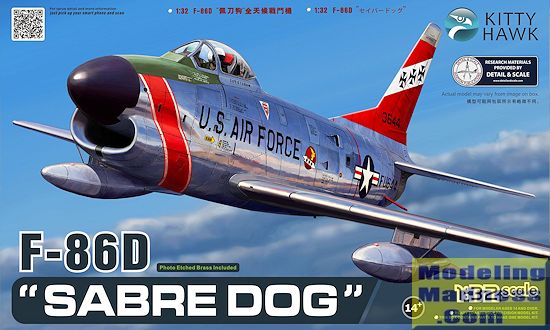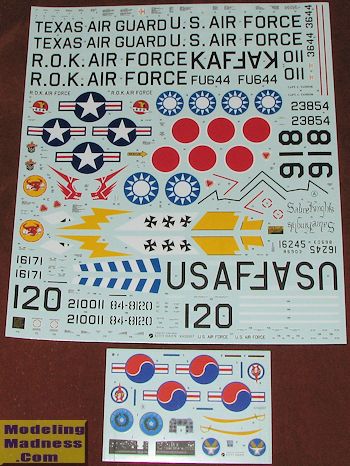
Kitty Hawk Models 1/32 F-86D Sabre
| KIT #: | KH 32007 |
| PRICE: | Should be in the $90.00 SRP range |
| DECALS: | Six options |
| REVIEWER: | Scott Van Aken |
| NOTES: | New tool |

| HISTORY |
The North American F-86D Sabre (sometimes called the "Sabre Dog" or "Dog Sabre") was a transonic jet all-weather interceptor of the United States Air Force and others. Based on North American's F-86 Sabre day fighter, the F-86D had only 25 percent commonality with other Sabre variants, with a larger fuselage, larger afterburning engine, and a distinctive nose radome.
The YF-95 was a development of the F-86 Sabre, the first aircraft designed around the new 2.75-inch (70 mm) Mighty Mouse Folding-Fin Aerial Rocket (FFAR), itself based on the German R4M rockets of WWII. Begun in March 1949, the unarmed prototype, 50-577, first flew on 22 December 1949, piloted by North American test pilot George Welch and was the first U.S. Air Force night-fighter design with only a single crewman and a single engine, a J47-GE-17 with afterburner rated at 5,425 lbf (24.1 kN) static thrust. Gun armament was eliminated in favor of a retractable under-fuselage tray carrying 24 unguided Mk. 4 rockets, then considered a more effective weapon against enemy bombers than a barrage of cannon fire. A second prototype, 50-578, was also built, but the YF-95 nomenclature was short-lived as the design was subsequently redesignated YF-86D.
The fuselage was wider and the airframe length increased to 40 ft 4 in (12.29 m), with a clamshell canopy, enlarged tail surfaces and AN/APG-36 all-weather radar fitted in a radome in the nose, above the intake. Later models of the F-86D received an uprated J-47-GE-33 engine rated at 5,550 lbf (24.7 kN) (from the F-86D-45 production blocks onward). A total of 2,504 D-models were built, equipping dozens of Air Defense Command squadrons in the US and many nation's air forces overseas.
On 18 November 1952, F-86D, 51-2945, set a speed record of 698.505 mph (1,124.1 km/h). Captain J. Slade Nash flew over a three km (1.8 mi.) course at the Salton Sea in southern California at a height of only 125 ft (38 m). Another F-86D broke this world record on 16 July 1953, when Lieutenant Colonel William F. Barns, flying F-86D 51-6145, in the same path of the previous flight, achieved 715.697 mph (1,151.8 km/h).
| THE KIT |
 Count
me as one of many modelers who have been anxiously awaiting this kit. I've
always been a huge Sabre fan ever since my father took me to the end of the
runway at Wheelus AFB on weekends in the very early 1950s to watch these
aircraft take off and land on their way to and from weapons practice in the
desert.
Count
me as one of many modelers who have been anxiously awaiting this kit. I've
always been a huge Sabre fan ever since my father took me to the end of the
runway at Wheelus AFB on weekends in the very early 1950s to watch these
aircraft take off and land on their way to and from weapons practice in the
desert.
The box is huge as you would expect of a plane of this size. All of the sprues are individually packaged with the clear bits coming in a sturdy little box. The main decal sheet is huge and won't fit on the platen of my scanner. There is minimal photo etch, this material being used for the seat harness and inside the speedbrake.
Since most builds and kit descriptions start in the cockpit, so will I. The seat is made up of ten pieces, not including the p.e. This fits into a very nicely done cockpit tub that has a radio rack fixed to the back of it. The side consoles are separate bits and you can put decals over the detail already there if you so wish. Ruddder pedals are included along with a single piece control stick and throttle.
Moveing to the nose gear well, you have a choice of finned or lobed nose wheels so check your references to see which is appropriate for what you are building. The base of the nose gear well is molded into the bottom of the forward intake section. You then add the fore and side bulkheads to it with the rear bulkhead being part of the seven piece missile tray well. The kit does provide a complete intake that goes all the way to the intake compressor face of the engine.
The engine is quite complete with separate burner cans, braces and a full afterburner section. The engine comprises some forty pieces. Looking at the way the kit is designed, one could easily just build up a bare skeleton engine in order to have something to attach the intake and exhaust section to as it will be pretty well hidden once the fuselage is completed.
The forward fuselage has two halves with a separate lower fuselage piece that will contain each of the five piece main gear wells. The missile tray is six parts and from the look of things is engineered to be displayed in the lowered position. A full radar antenna is provided for the nose section, though the instructions again show this disappearing behind the radome. At this point, I should mention that there is no indication that any nose weight is needed, though there is ample room for it above the intake and in front of the cockpit.
There is a separate tail section, though I'm not sure why,
though it may have to do with mold size limitations or the fact that if Kitty
Hawk wants to do an F-86K, they would only have to mold new forward fuselage
sections. All the flight surfaces have separate control surfaces and it appears
that the flaps are molded in the down position. I should mention that Kitty Hawk
has already opened the holes for the pylons and this includes the Sidewinder
pylons. I'm not sure how many F-86Ds were actually outfitted with these.
 I'm
pretty sure no US planes were other than tests, though the later F-86L may have
been. There are no images in my references that show this being fitted to any
radar nose F-86. You will probably want to fill those inner holes. I should add
that Kitty Hawk has properly molded all the little vortex generators on the kit
so you don't have to try to duplicate these with teensy bits of p.e.
I'm
pretty sure no US planes were other than tests, though the later F-86L may have
been. There are no images in my references that show this being fitted to any
radar nose F-86. You will probably want to fill those inner holes. I should add
that Kitty Hawk has properly molded all the little vortex generators on the kit
so you don't have to try to duplicate these with teensy bits of p.e.
 nstructions
are nicely done and in booklet form. It provides FS 595 and generic color
information. There are full color painting and markings diagrams on the
cover of the instructions that include some fold out pages. Six options are
provided. All except one are in unpainted metal. First up is the box art
plane from the 82nd FIS. Moving down the diagram is a South Korean plane,
then a Japanese version, followed by a Taiwanese version. This aircraft is
listed as being in over light gull grey, but I'm betting it is probably ADC
grey since it came from the USAF. Choice is yours. Next with large
fluorescent areas is a plane from the 181st FIS, Texas ANG, and finally is a
325 FIS plane from the 'Sabre Dancers' display team. All the large bands and
fin stripes need to be painted on, which is probably for the best. The white
outlines for the box art nose band is on the sheet. The main sheet is huge
and would not fit on my scanner. The markings are superbly done and should
provide no issues at all.
nstructions
are nicely done and in booklet form. It provides FS 595 and generic color
information. There are full color painting and markings diagrams on the
cover of the instructions that include some fold out pages. Six options are
provided. All except one are in unpainted metal. First up is the box art
plane from the 82nd FIS. Moving down the diagram is a South Korean plane,
then a Japanese version, followed by a Taiwanese version. This aircraft is
listed as being in over light gull grey, but I'm betting it is probably ADC
grey since it came from the USAF. Choice is yours. Next with large
fluorescent areas is a plane from the 181st FIS, Texas ANG, and finally is a
325 FIS plane from the 'Sabre Dancers' display team. All the large bands and
fin stripes need to be painted on, which is probably for the best. The white
outlines for the box art nose band is on the sheet. The main sheet is huge
and would not fit on my scanner. The markings are superbly done and should
provide no issues at all. | CONCLUSIONS |
I'm all for this one but then again, I'm biased as I like Sabres. It does not look overly complex and should be something just about any modeler of more than basic skills should be able to finish to a high level. It has tons of detail and should engender a spate of large scale decal sheets. This one has made its way to the top of my build pile.
| REFERENCES |
http://en.wikipedia.org/wiki/North_American_F-86D_Sabre
The North American Sabre, by Ray Wagner, MacDonald & Co, 1963
February 2015 Thanks to Kitty Hawk Models and Glen
Coleman for the preview kit. If you would like your product reviewed fairly and fairly quickly, please contact the editor or see other details in the
Note to
Contributors.